Last Updated on: 5th August 2024, 01:07 pm
While millions of international tourists flock to Quintana Roo each year, the state remains home to hidden gems that fall well under the radar. In Quintana Roo’s south, right near the border with Campeche, are two well-preserved but underrated Mayan sites that are worth the extra effort to see. In the following guide, we’ll be covering how to go about visiting Kohunlich and Dzibanché and what you can expect at each site.
In summary, the ruins can only be accessed with some kind of private transport or tour, either from Xpujil, Campeche or Bacalar/Chetumal, Quintana Roo. Check the very end of the article for more details.
At the time of writing, Kohunlich is open daily from 8:00 and costs $85 MXN to enter. Dzibanché is also open daily from 9:00 and costs $70 MXN. A ticket to Dzibanché also includes entry to the pyramid of Kinichná.
However, you may need to pay extra to local residents who are currently operating a roadblock several kilometers from the the site (learn more below).
Visiting Kohunlich
Kohunlich is a well-preserved site that when compared with other Mayan ruins, could be considered medium in size. As no public transport goes there, it remains relatively obscure. You might encounter groups of cruise ship passengers on a day tour, however, so it’s best to come early.
Established in the early 6th century AD, the city remained inhabited until around the 13th century. Architecturally, the city represents a mix of the Río Bec style of the sites around Xpujil and the Petén style of Guatemala.
The true extent of Kohunlich’s historical relationship with either of these two regions, however, remains a mystery.
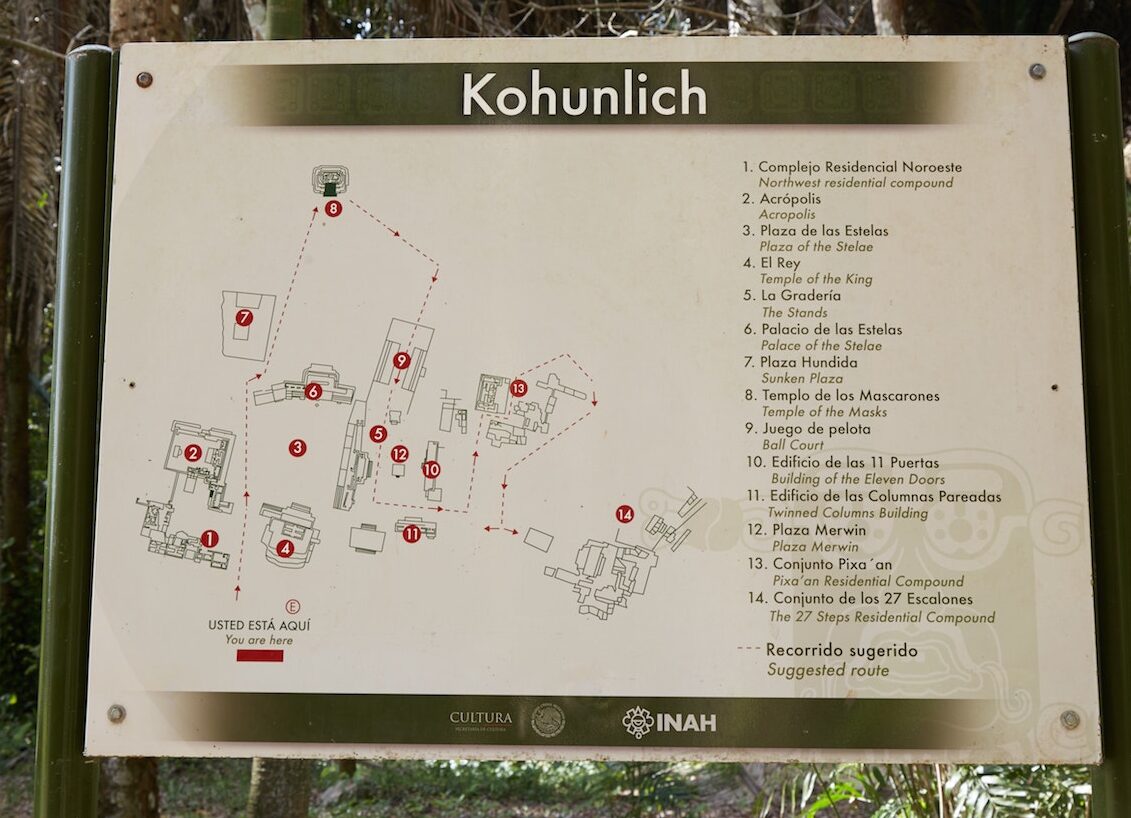
Plaza of the Stelae
Upon entering the site, one of the first structures you’ll encounter is a large platform known as the Temple of the King. As we’ll cover below, the structure can be climbed, but the staircase is on the other side, accessible from Plaza Merwin.
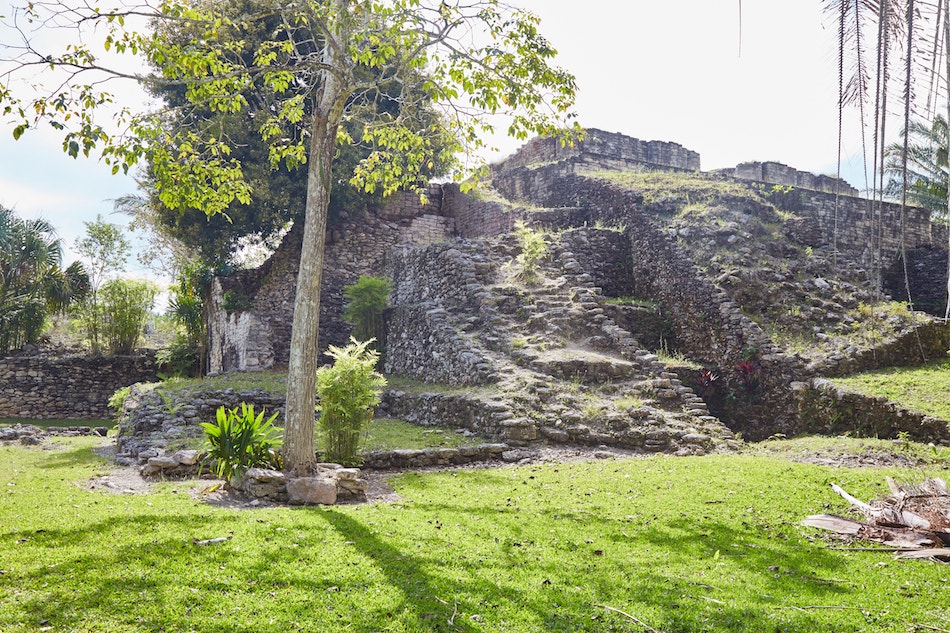

On the other side of the entryway, meanwhile, is the Northwest Residential Compound. Occupied between 600 and 1200 AD, it’s believed to have housed a group of artisans who specialized in making items out of shell. The complex was gradually remodeled and expanded over time.
Just ahead is the Acropolis, Kohunlich’s single largest construction.

Around the top, you’ll encounter the ruins of various structures which may have served as a residential complex for the elite. It’s also from atop the Acropolis that one can enjoy the best views of the Plaza of the Stelae down below.

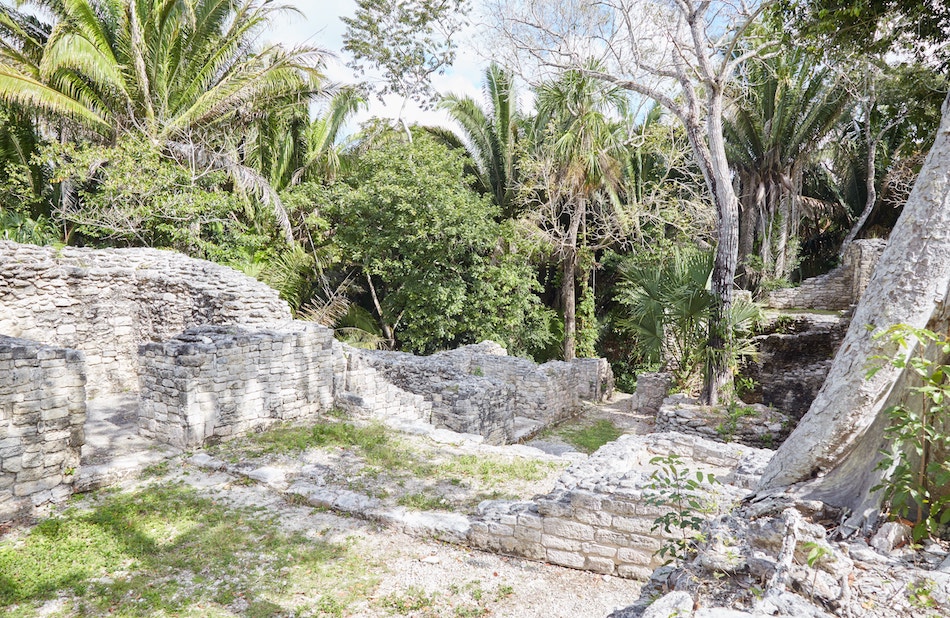
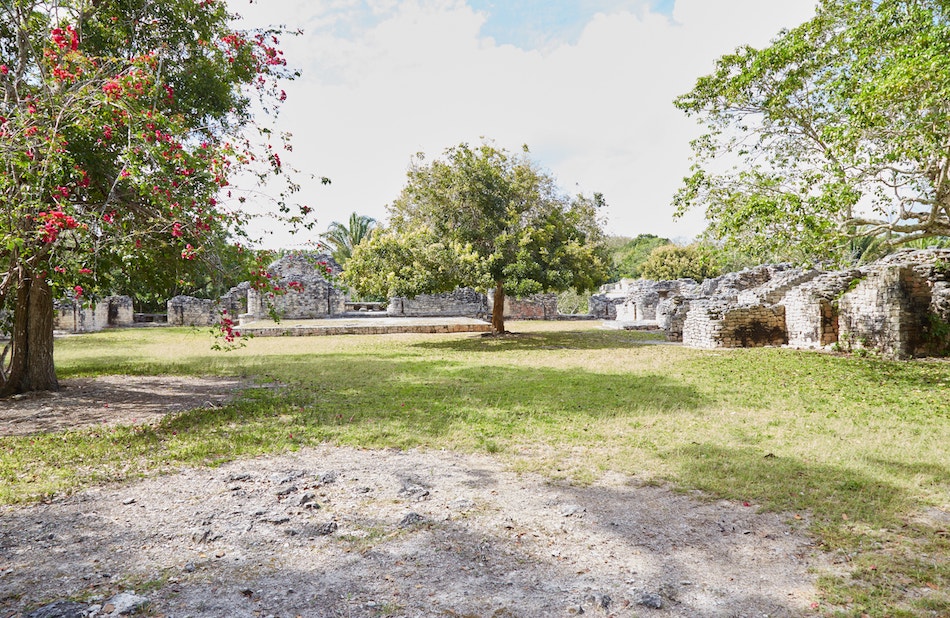
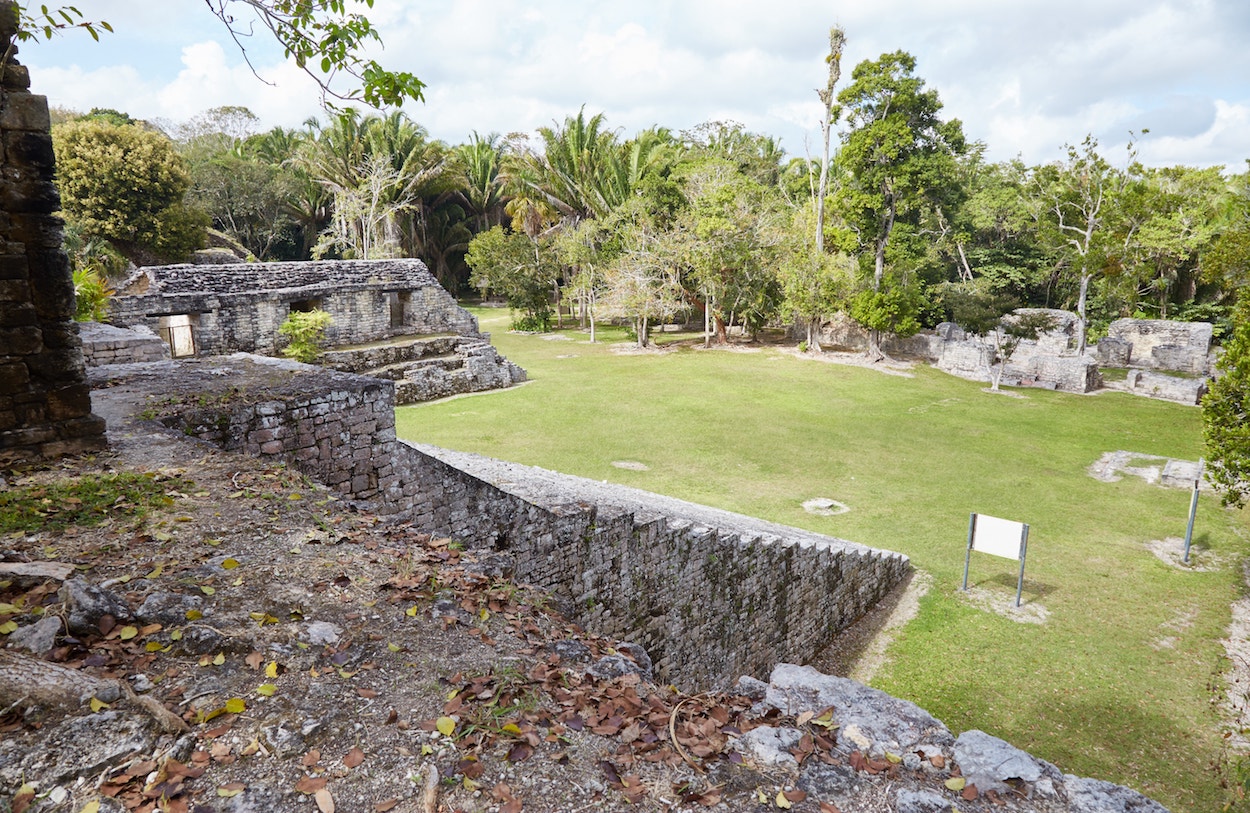
Coming back down, it’s worth walking all around the base of the Acropolis to get a sense of just how big it really was. Mysteriously, it seems to have contained secret chambers accessible from the lower level.
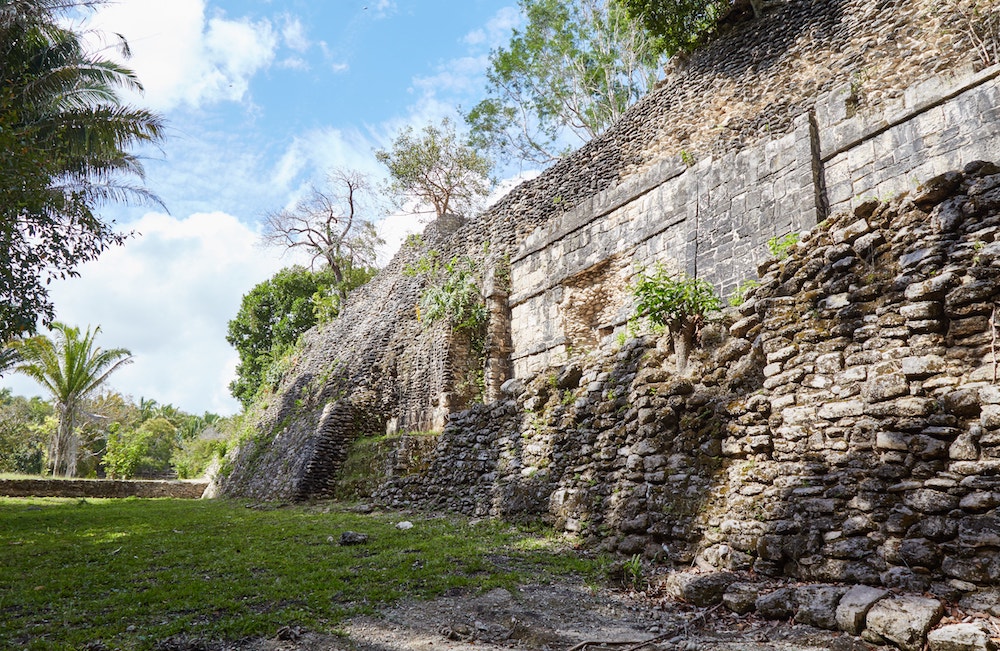

The Plaza of the Stelae was the central plaza of the city and where many of Kohunlich’s most important ceremonies would’ve taken place.
To its east lies a structure known as the Palace of the Stelae, built around the year 600. It features three stelae at its base, though they appear to have never been carved. Archaeologists, therefore, believe they were all originally plastered over and painted.
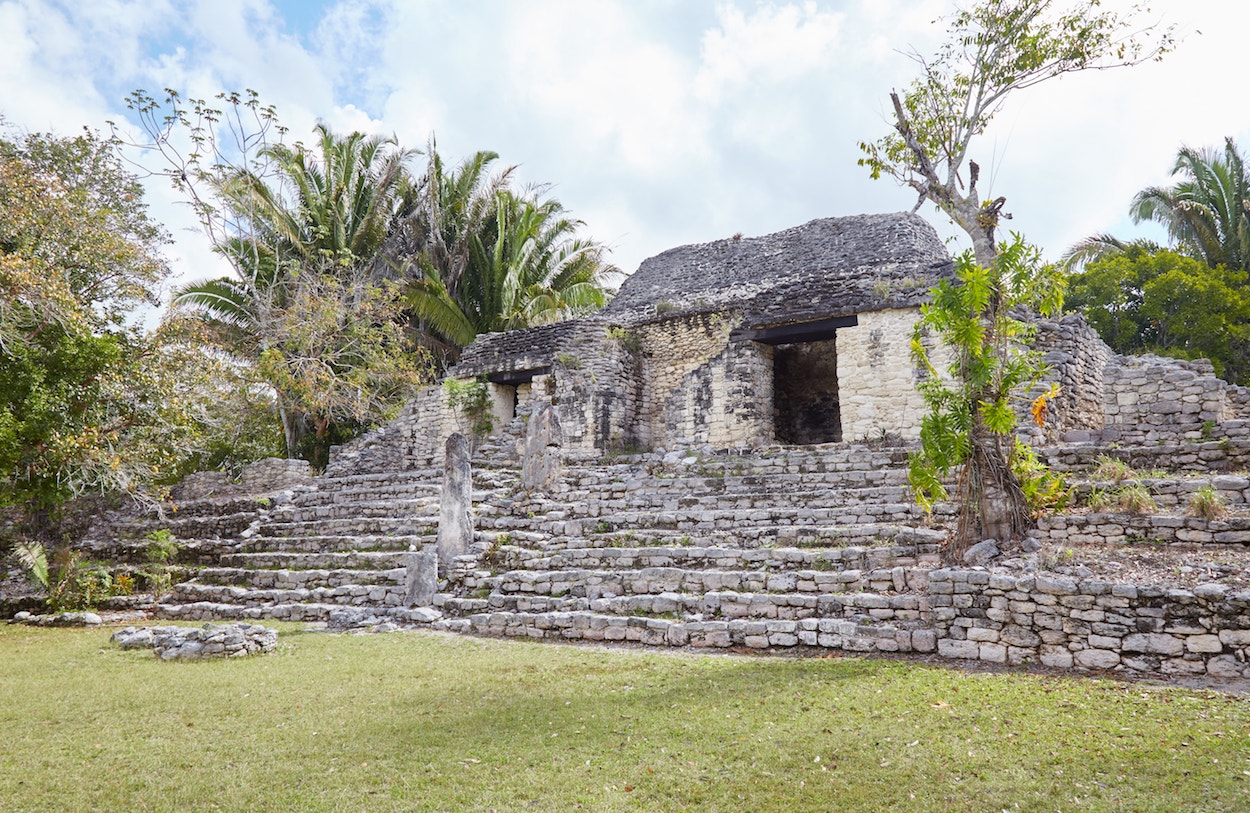
Temple of the Masks
Leaving the plaza, you’ll find a forested path taking you further east to the Temple of the Masks – arguably Kohunlich’s top highlight. Built around the year 500 AD, it’s one of the city’s oldest constructions.
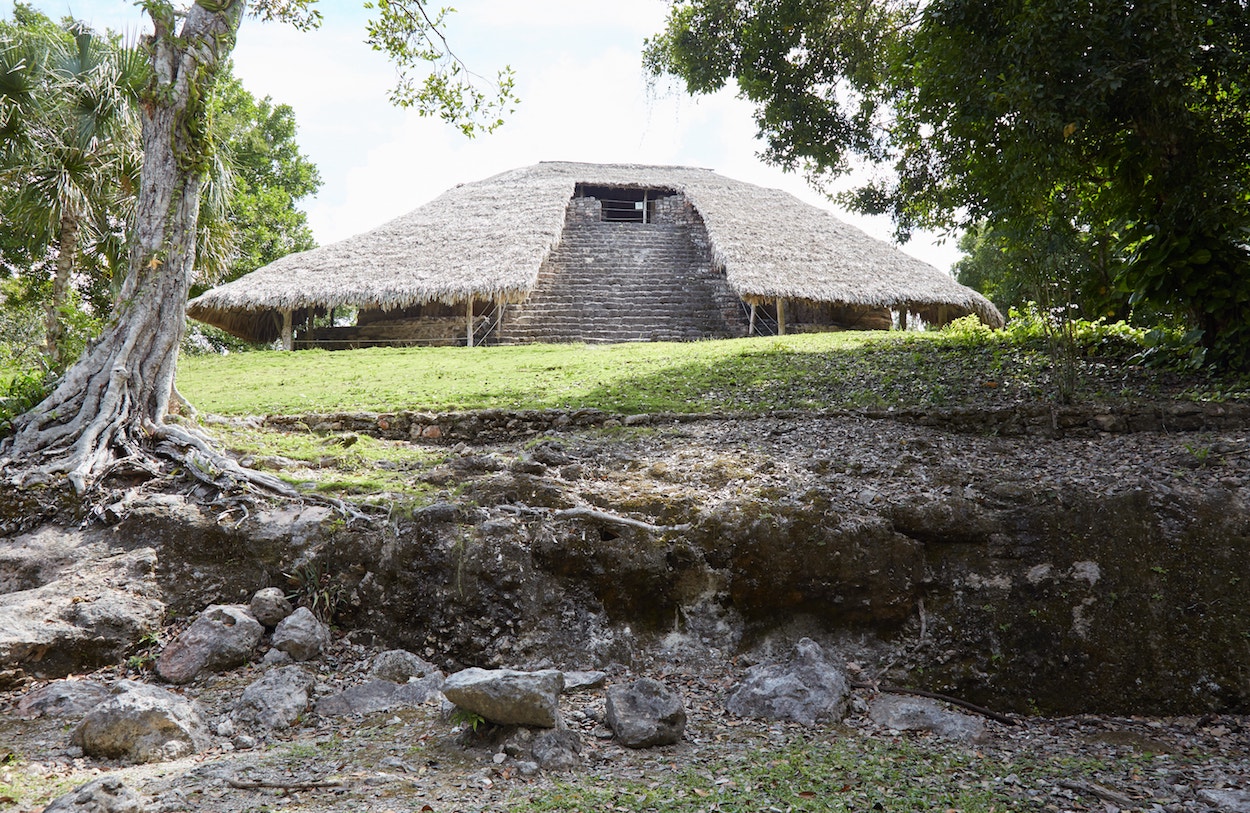
As the name suggests, the pyramid is decorated with ornate masks on either side of the staircase, each around 2.5 meters tall.
They represent Kinich Ahau, one manifestation of the Mayan Sun God. But they may have also represented various member of the ruling dynasty. Notably, the masks face west toward the setting sun.

While the masks were added in the initial Early Classic period building phase, they were later covered over by a second building phase around the year 700. But as this second phase was shoddily built, the masks eventually revealed themselves over time.

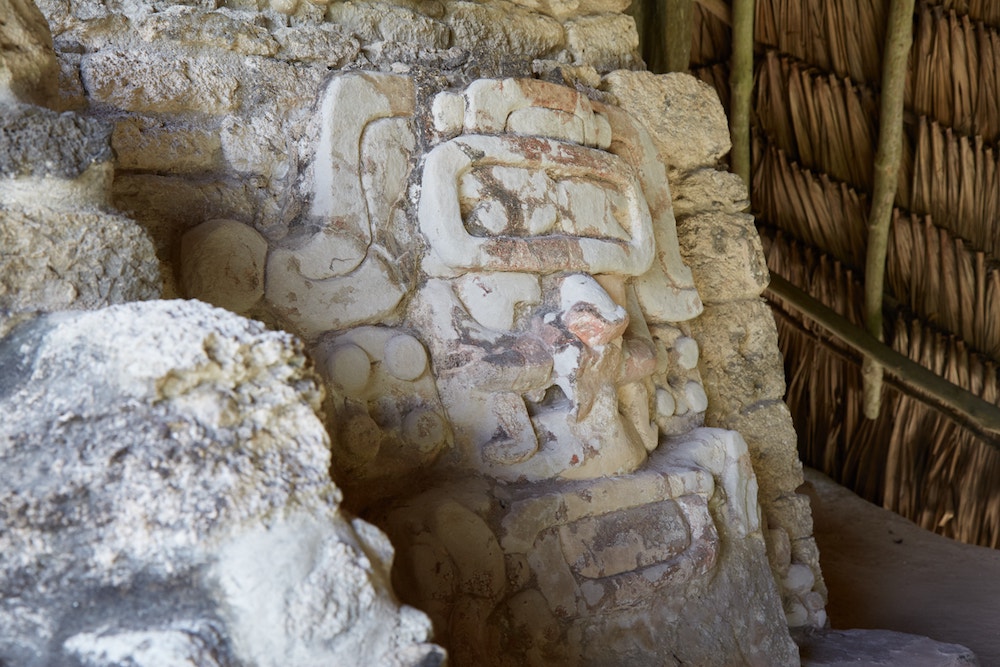
The impressive masks are now protected by a thatched roof. The pyramid remains climbable, though the small temple at the top appears largely empty.
The Temple of the Masks is remarkable for being one of the few Mayan pyramids to maintain its original stucco decorations. Many other Mayan other pyramids throughout Mexico were built in this style, though few still have their faces intact.


Plaza Merwin
From the Temple of the Masks, take the path leading you southwest and you should soon encounter the ball court. If you’ve already been to several Mayan sites or Mesoamerican ruins in general, it should come as no surprise to find one.
While the rules likely varied from city to city, the court was where two teams would hit a rubber ball with their hips and thighs in hopes of getting it through a stone hoop. The game was highly symbolic, representing the movement of the cosmos and forces of light against those of darkness.

Just past the ball court is the Merwin Plaza. Located right next to the Plaza of the Stelae, it feels like an entirely different section of the city. Not only is it more densely crowded with various small structures, but the abundant trees still standing here give it a dim and mysterious atmosphere.



The plaza was believed to have been built after the main one, and it was here that relatively minor ceremonies would take place.
Many of the buildings here, such as the Building of the Eleven Doors, the Twinned Columns Building and a residential complex, were built in the style of nearby Río Bec.

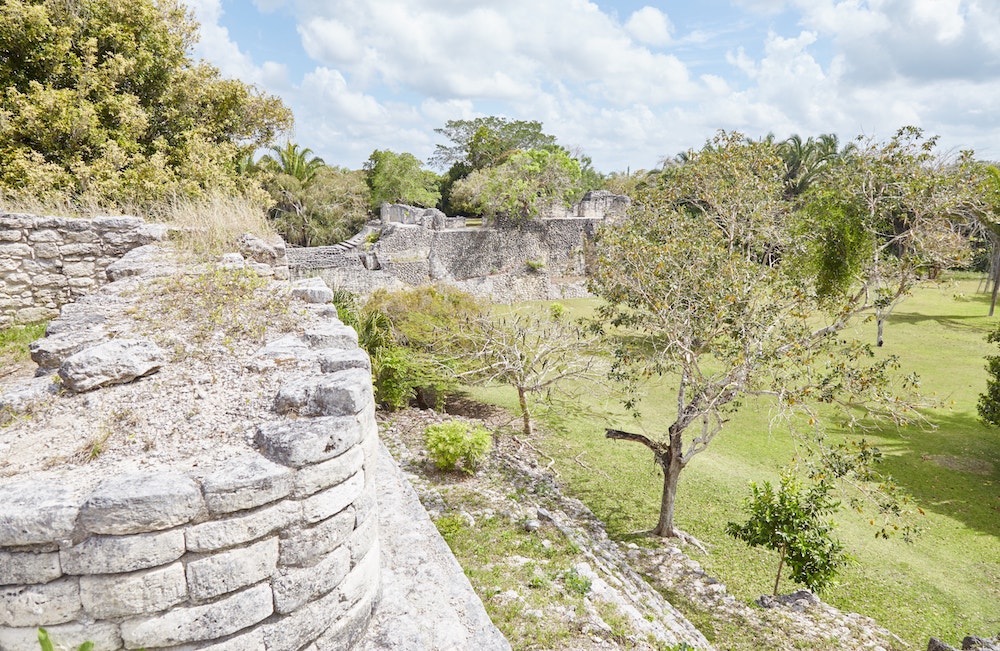
27 Steps
A forested path leads to the far south of the archaeological site, where you’ll find an elaborate residential complex known as ’27 Steps.’ As one might guess, it was named after the number of steps built to reach the natural hill on which it was built.
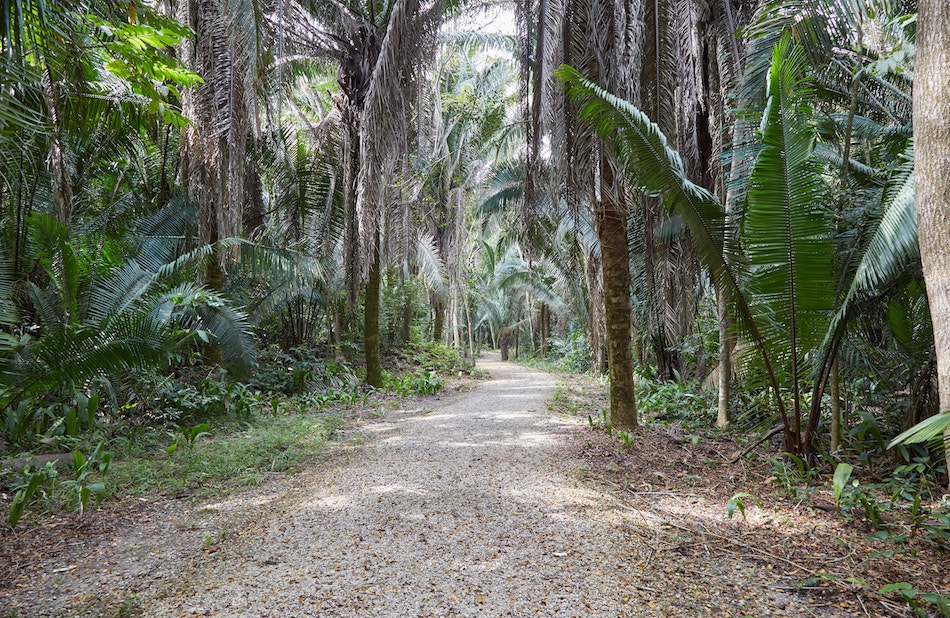
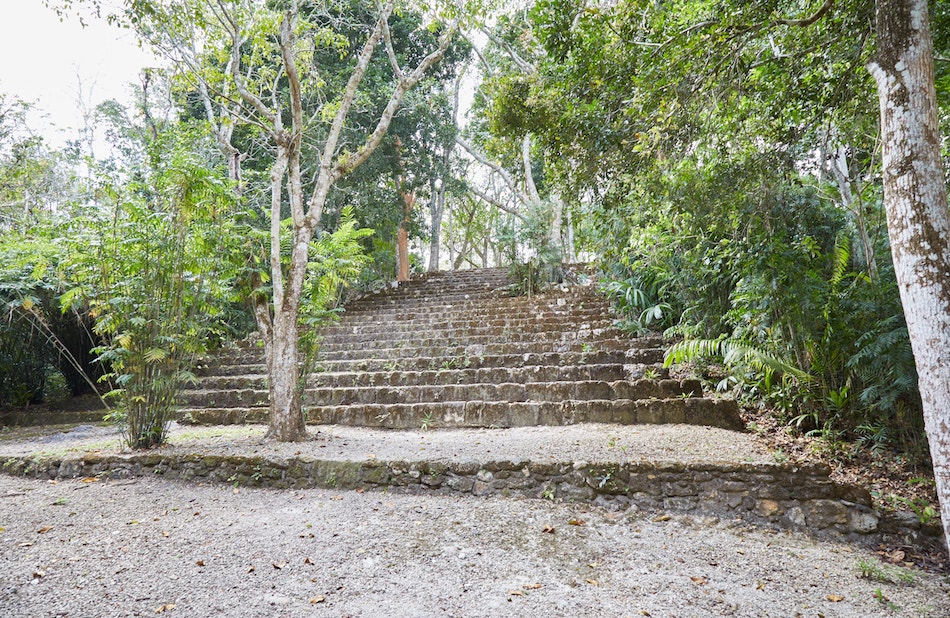
The buildings are quite well-preserved, and with a bit of imagination, one can picture what daily life may have been like for the Kohunlich elite.
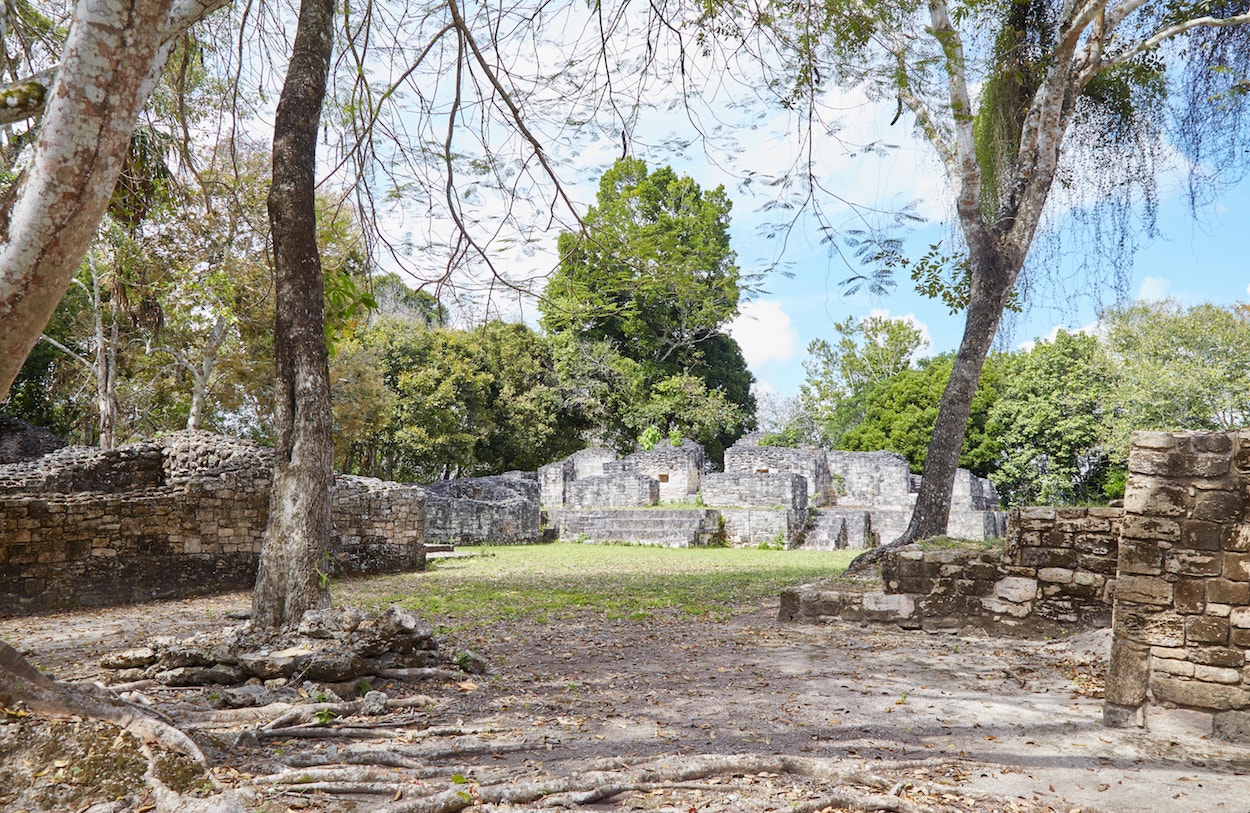
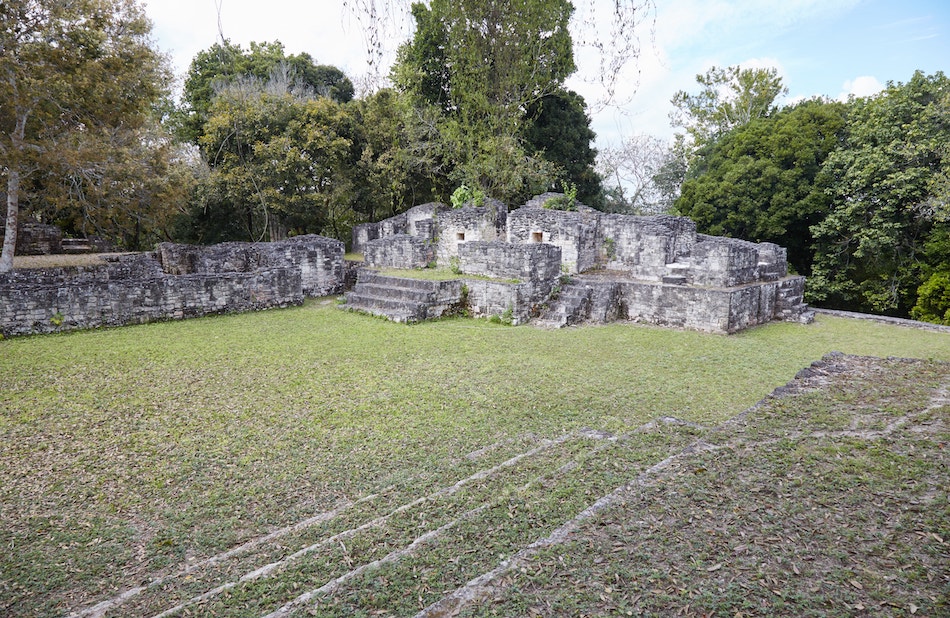
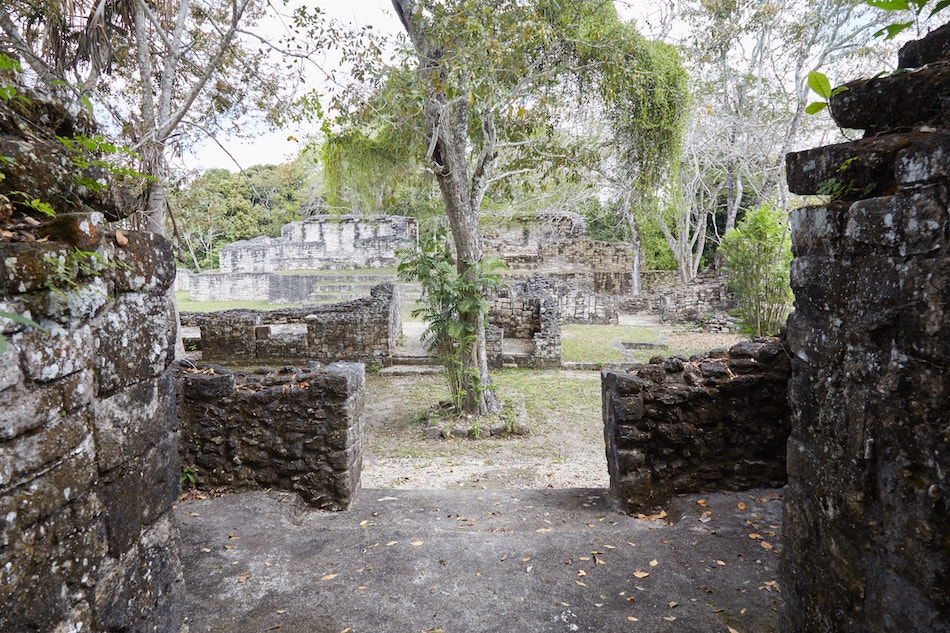
Dzibanché
IMPORTANT NOTE: After turning off Highway 186 and heading north, you’ll eventually need to turn right to reach Dzibanché. But at the time of writing, local villagers are operating a road block here for those wishing to reach the ruins.
Based on what they told my driver and I, they got fed up with seeing tourists use the road daily without them ever receiving money from the government who manages the site. Therefore, they decided to take matter into their own hands, charging all outsiders a fee they say they’ll use for future repairs.
While I was sympathetic to their plight at first, all sympathy vanished when I heard they wanted $100 MXN from foreigners! (Mexicans, in contrast, only pay 50 pesos). This extra payment is something to keep in mind when calculating your budget for the day. As I’d later learn, this sort of situation is not all that uncommon in Mexico.
Historically speaking, one of Dzibanché’s most remarkable aspects is that based on an inscription found at the site, it’s believed to be the origin of the Kaan dynasty who’d later go on to rule Calakmul.
As Calakmul, about 130 km away, would go onto become one the greatest and most powerful cities in Mayan history, this is no insignificant detail.
The Kaans, or ‘People of the Snake,’ likely ruled Dzibanché throughout the 5th and 6th centuries. But even after they left for Calakmul, Dzibanché would continue to thrive, with its last dated text being carved in 909.
Structure 6
Dzibanché is remarkable for containing several large pyramids, which apparently gave the Kaan dynasty useful experience before they’d go on to build the massive ‘Structure 2’ pyramid of Calakmul.

Entering the site, you’ll immediately encounter Structure 6 or ‘Temple of the Lintels.’ And like many of the structures here, it’s climbable. At the top, you’ll find a set of two temples with two vaulted galleries.
While no longer evident today, the pyramid once would’ve been entirely decorated in painted stucco. But what can still be seen is a carved wooden lintel beam dating to the mid-6th century.
The earliest phase of Structure 6 was built in the Early Classic period (300-600 AD), while the upper temple would be added several centuries later.

The Gann Plaza
Continuing down a trail south, you’ll encounter the Gann Plaza, named after Thomas Gann, the first archaeologist to study the site in the 1920s. It’s home to a multitude of different structures, though we’ll just be focusing on the highlights below.


At the north end of the plaza stands Structure 16. It features a long staircase that was intended for special ceremonies.
Construction on this building took place over the course of several centuries. Interestingly, remnants of the stone over which stucco masks were once placed can still be seen.


To the west, you’ll find Structure 14, a small pyramid. It once contained two rooms at the top which are now missing. The most remarkable thing about this building are the remnants of stucco friezes along some of the steps which seem to depict local rulers.
The the east is the highlight of the Gann Plaza, Structure 2, also known as the Cormoranes Pyramid. This impressive structure is the largest pyramid of the site, and it was built in the 5th century in a style influenced by Teotihuacán.


Most notably, the pyramid served as the mortuary temple of King Sky Witness of the Kaan dynasty.
At the top is a temple with two galleries, though unlike the other pyramids at Dzibanché, this one isn’t climbable at the time of writing.
Along the sides, one can see various remnants of the original stucco decorations which are now protected under thatched roofs.
Plaza Xibalba
Just to the east of Plaza Glann is Plaza Xibalba, lined on either side by two long palaces built atop tall platforms. Each palace consists of nine openings, a number synonymous with the nine lords of the underworld. Hence we get the plaza’s name, Xibalba (the Mayan underworld).


While both palaces once featured staircases, they were dismantled and their stones usurped at some point in pre-Hispanic times.



On the other side of the plaza is yet another large pyramid known as Structure 1, or Temple of the Owl. Built in the Petén style of architecture, it contained the tomb of a high-ranking female. And inside, numerous funerary artifacts and jewelry were discovered.
Furthermore, the exterior would’ve been decorated in stucco friezes, including masks on either side of the stairway – much like Kohunlich’s Temple of the Masks.
This pyramid can be climbed, and from the top you can enjoy great views of Dzibanché and its surroundings.

Residential Area & the Small Acropolis


Finished with the pyramids, you’ll find a trail taking you to a secluded forested area, where you’ll encounter numerous densely-packed plazas. The buildings here were likely residential palaces for the ruling elite.



Up a staircase is the Small Acropolis, where archaeologists have discovered a wide variety of objects, including censers, golden ornaments and obsidian knives. Some stucco artwork also remains partially preserved as well.
While I didn’t encounter any treasures, I did nearly step on a snake!

Kinichná
If it wasn’t clear already that the Kaan rulers really liked building pyramids, you can find yet an even larger one at the nearby site of Kinichná, just a few kilometers away from Dzibanché.
In fact, the site consists of nothing but a single structure, which explains why it’s included in the same entry ticket.


Built sometime in the Early Classic period (300-600 AD), the pyramid consists of three main levels. The base is so large that from the back and sides, it looks like a natural hill covered in thick overgrowth. Only the front has been cleared thus far.

Ascending the first staircase, you’ll reach Level B, home to two temples with vaulted corridors. In ancient times, they would’ve been decorated with large masks like the ones mentioned above.


Next is Level C, which also features two temples, though this time they share a single corridor. It would’ve been richly decorated in stucco and paint in its heyday.
Furthermore, the top was once adorned with an image of Mayan Sun God, Kinich Ahau, from which the pyramid now takes its name.

As with the pyramids of Dzibanché and Calakmul, this pyramid was also used as a tomb. Entombed within were two high-ranking individuals, buried together with a cache of jade artifacts said to be among the finest ever discovered in the area.

Oddly, the on-site placard does not mention the pyramid’s total height, nor can I find this information online. In any case, the views from the top are incredible.
Even having just visited Calakmul and the ruins surrounding Xpujil, climbing Mayan pyramids never gets old.

Additional Info
Kohunlich and Dzibanché are located in between Xpujil (Campeche state) and Bacalar/Chetumal (Quintana Roo state), about an hour drive from either.
No public transport goes to these ruins, so you’ll either need to rent a car, hire a private driver, or take a group tour.
This highly-rated tour, for example, can take you to both Dzibanché and Kohunlich from Bacalar.
In my case, I was staying in Xpujil before heading to Bacalar. And as the managers of my guest house, Hotel Chaac Calakmul, also run a travel agency, I inquired about arranging a private driver who could take me to the ruins and then drop me off in Bacalar.
We ended up settling on a price of $1500 MXN, or about $75 USD. While I didn’t shop around, this price seemed fair considering how the shuttles to Calakmul cost about $500 MXN per person but need at least three passengers.
Considering how there’s no direct transport between Xpujil and Bacalar, hiring a driver also meant I didn’t need to do an extra transfer in Chetumal.
Being a frugal traveler, I’d originally considered finding a colectivo from Xpujil that could take me to the town of Nicolás Bravo, from where I’d try finding a taxi to both ruins. While perhaps a possibility, this would’ve been much more difficult to figure out and I may not have saved that much money anyway.
As Calakmul becomes more well-known, more and more travelers are including the nearest town of Xpujil in their itineraries. Additionally, as the beautiful lagoon of Bacalar becomes increasingly popular, many are realizing that Xpujil is a quick drive away.
As such, there are quite a few accommodation options to choose from. Being a budget traveler who prefers a private room and bathroom, I went with Hotel Chaac Calakmul. I had a nice experience there, as it was well-located and had functioning internet and AC.
I paid roughly $14 USD per nigh including tax. As mentioned above, the owners also run a travel agency, so it was easy to arrange private transport with one of them to Kohunlich and Dzibanché. They also arranged shared transport to Calakmul for $500-600 MXN.
